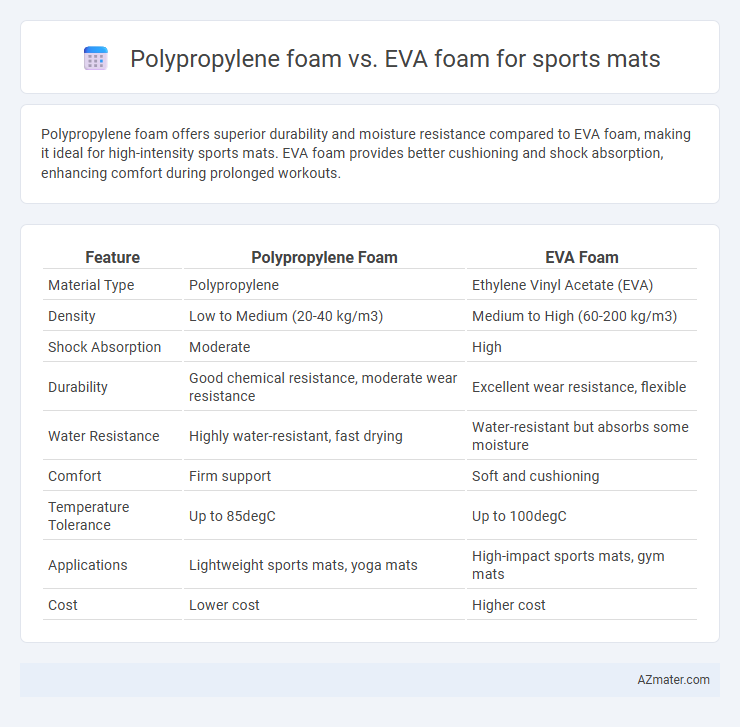Polypropylene foam offers superior durability and moisture resistance compared to EVA foam, making it ideal for high-intensity sports mats. EVA foam provides better cushioning and shock absorption, enhancing comfort during prolonged workouts.
Table of Comparison
| Feature | Polypropylene Foam | EVA Foam |
|---|---|---|
| Material Type | Polypropylene | Ethylene Vinyl Acetate (EVA) |
| Density | Low to Medium (20-40 kg/m3) | Medium to High (60-200 kg/m3) |
| Shock Absorption | Moderate | High |
| Durability | Good chemical resistance, moderate wear resistance | Excellent wear resistance, flexible |
| Water Resistance | Highly water-resistant, fast drying | Water-resistant but absorbs some moisture |
| Comfort | Firm support | Soft and cushioning |
| Temperature Tolerance | Up to 85degC | Up to 100degC |
| Applications | Lightweight sports mats, yoga mats | High-impact sports mats, gym mats |
| Cost | Lower cost | Higher cost |
Introduction to Sports Mat Materials
Polypropylene foam offers lightweight durability and excellent resistance to moisture and chemicals, making it a preferred choice for sports mats where hygiene and longevity are crucial. EVA foam provides superior shock absorption and cushioning with enhanced flexibility, ideal for high-impact activities requiring joint protection and comfort. Both materials deliver unique benefits aligned with different sports applications, balancing factors such as density, resilience, and cost efficiency.
What is Polypropylene Foam?
Polypropylene foam is a lightweight, closed-cell material known for its excellent durability, moisture resistance, and high impact absorption, making it ideal for sports mats. It offers superior thermal insulation and chemical resistance compared to EVA foam, which is softer and more flexible but less resilient. These properties enable polypropylene foam to provide enhanced support and longevity in high-impact sports environments.
What is EVA Foam?
EVA foam, or Ethylene Vinyl Acetate foam, is a highly flexible and durable material commonly used in sports mats due to its excellent shock absorption and cushioning properties. It features a closed-cell structure that provides superior water resistance and long-lasting support, making it ideal for impact protection in various athletic activities. Compared to polypropylene foam, EVA offers enhanced comfort and resilience, which contributes to reduced fatigue and improved performance during exercise.
Density and Cushioning Comparison
Polypropylene foam offers higher density ranging from 30 to 80 kg/m3, providing firm support suitable for high-impact sports mats, while EVA foam typically has a lower density between 25 to 70 kg/m3, offering softer cushioning and enhanced shock absorption. The cushioning capability of EVA foam is superior due to its closed-cell structure, which effectively absorbs impact and reduces joint strain, whereas polypropylene foam emphasizes durability and structural integrity in sports applications. Choosing between polypropylene foam and EVA foam depends on the required balance between firmness and comfort for specific athletic activities.
Durability and Wear Resistance
Polypropylene foam offers superior durability and excellent wear resistance, making it highly suitable for sports mats exposed to frequent impact and abrasion. EVA foam provides good cushioning and flexibility but generally exhibits less resistance to long-term wear compared to polypropylene. For sports mats requiring prolonged durability under rigorous use, polypropylene foam is the preferred material.
Shock Absorption and Impact Protection
Polypropylene foam offers superior durability and excellent shock absorption, making it ideal for high-impact sports mats that require consistent performance under stress. EVA foam provides enhanced cushioning and impact protection due to its closed-cell structure, which effectively absorbs and disperses forces during falls or heavy contact. Both materials excel in shock absorption, but EVA foam's flexibility and resilience make it particularly suitable for activities demanding greater comfort and joint protection.
Water and Sweat Resistance
Polypropylene foam exhibits superior water and sweat resistance compared to EVA foam, making it ideal for sports mats exposed to moisture. Its closed-cell structure prevents water absorption, ensuring long-lasting durability and hygiene. EVA foam tends to absorb sweat more readily, which can lead to odor retention and quicker material degradation over time.
Eco-Friendliness and Recyclability
Polypropylene foam offers superior eco-friendliness due to its recyclable nature and lower environmental impact during production compared to EVA foam, which often contains chemical additives hindering biodegradability. EVA foam is less recyclable and tends to persist longer in landfills, raising concerns about long-term environmental sustainability for sports mats. Choosing polypropylene foam promotes a circular economy through easier recycling and reduced carbon footprint in sports mat manufacturing.
Cost Analysis: Polypropylene vs. EVA Mats
Polypropylene foam sports mats generally cost less than EVA foam mats due to lower raw material and manufacturing expenses, making them a budget-friendly option for large-scale or recreational use. EVA foam offers superior cushioning and durability, often justifying its higher price point in professional or high-impact sports environments. Evaluating long-term costs includes considering EVA's enhanced longevity and shock absorption, which may reduce replacement frequency compared to polypropylene mats.
Which Foam is Best for Your Sport?
Polypropylene foam offers excellent durability and moisture resistance, making it ideal for high-impact sports that require long-lasting support and easy maintenance. EVA foam provides superior cushioning and flexibility, enhancing comfort and shock absorption for activities involving repetitive movements or extended floor contact. Choosing the best foam depends on your specific sport's demands: polypropylene foam suits intense, rugged use, while EVA foam excels in providing comfort and protection during yoga, Pilates, or aerobics.

Infographic: Polypropylene foam vs EVA foam for Sports mat
 azmater.com
azmater.com